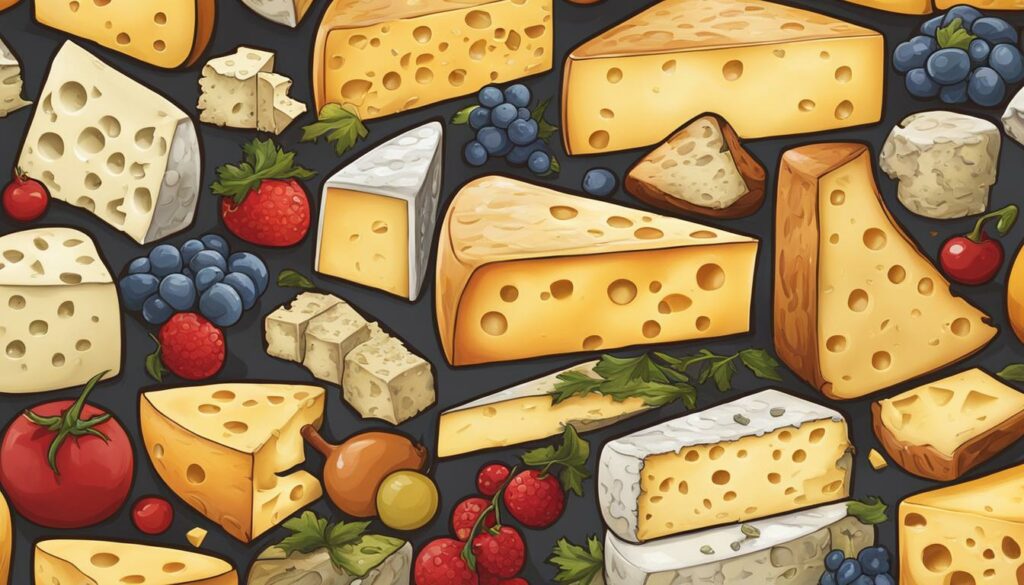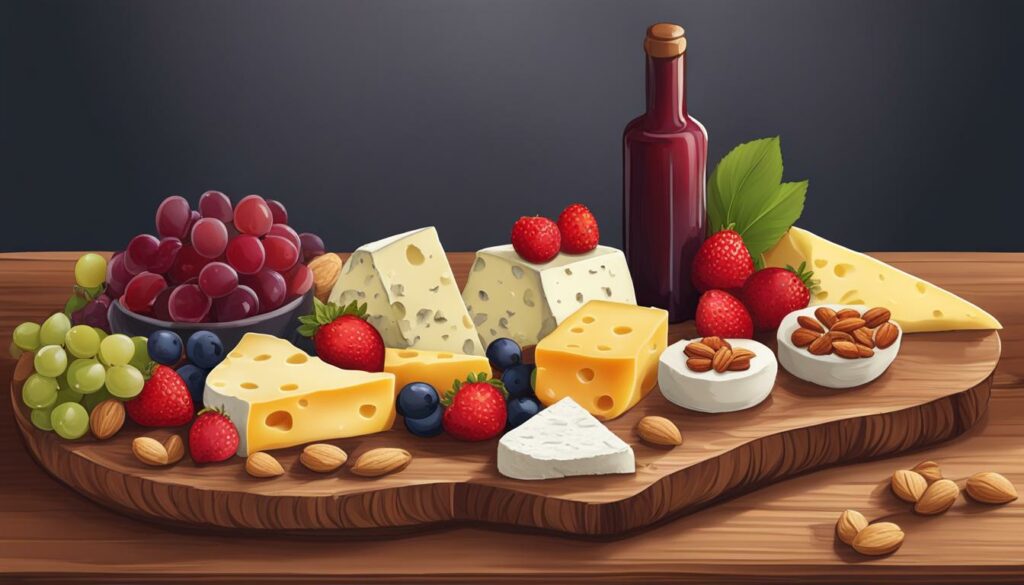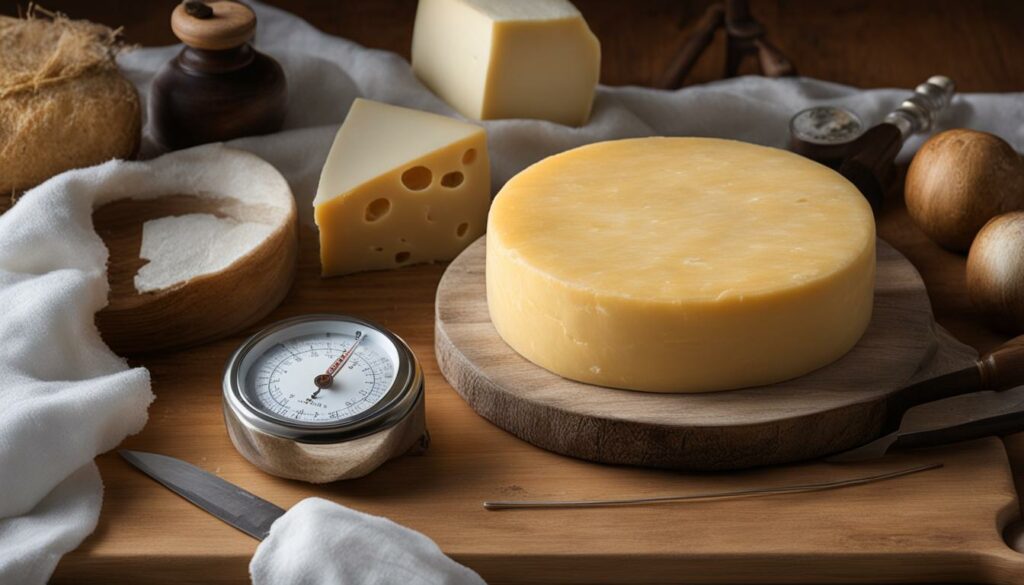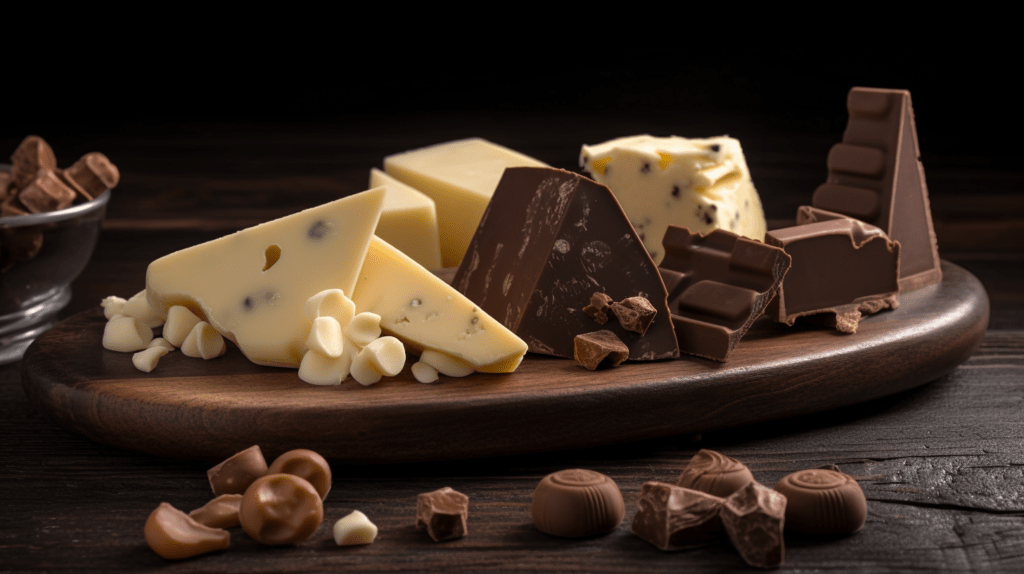Have you ever wondered how many types of cheese exist in the world? Is it a handful? A hundred? Or maybe a thousand? Brace yourself, because the answer may surprise you. There are over 1,800 different types of cheese estimated to exist, each with its own unique characteristics and qualities. From creamy bries to aged cheddars, and from tangy blues to crumbly feta, the world of cheese is a vast and diverse landscape just waiting to be explored.
In this article, we will delve into the fascinating world of cheese varieties, unraveling the different types of cheese found around the world, exploring popular cheese varieties, discovering the various categories of cheese. Find out how cheese is prepared and aged impacts its flavor and texture, and learn how to pair cheese and use it in various culinary creations. So, are you ready to embark on a delicious journey through the world of cheese? Let’s get started!
The World of Cheese Variety
The world of cheese offers a vast array of variety. With over 1,800 estimated types of cheese, there is something to suit every palate. Cheese can be classified into different categories based on factors such as milk source, aging process, texture, and flavor. Exploring the diversity of cheese types allows for a deeper appreciation of the artistry and craftsmanship that goes into cheesemaking.
Understanding the Diversity of Cheese Types
Cheese is a beloved food that has been enjoyed by cultures around the world for centuries. Its rich history and cultural significance have resulted in a wide range of cheese types, each with its own unique characteristics. From soft and creamy Brie to sharp and tangy Cheddar, there is a cheese to satisfy every taste preference.
The diversity of cheese types can be attributed to several factors. The first is the milk source. Cheeses can be made from cow’s milk, goat’s milk, sheep’s milk, or buffalo milk. Each type of milk imparts its own distinct flavor profile to the cheese, resulting in a wide range of taste experiences.
Another factor that contributes to the diversity of cheese types is the aging process. Some cheeses are meant to be consumed fresh, while others are aged for months or even years. The aging process affects the texture and flavor of the cheese, creating a spectrum that ranges from soft and creamy to hard and crumbly.
The texture of cheese also varies greatly, from smooth and silky to grainy and firm. This is influenced by factors such as moisture content and the presence of air pockets in the cheese.
Lastly, the flavor of cheese is influenced by a variety of factors, including the milk source, aging process, and the introduction of mold or bacteria cultures during cheesemaking. This results in a wide range of flavors, from mild and buttery to strong and pungent.
By understanding and exploring the diversity of cheese types, cheese enthusiasts can expand their culinary horizons and discover new and exciting flavors.
Estimates and Classifications of Cheese Categories
With such a vast variety of cheese types, it can be helpful to classify them into categories. This allows for easier navigation and understanding of the cheese landscape.
There are several commonly recognized cheese categories, including:
- Fresh cheeses: These are cheeses that are consumed soon after they are made and have not undergone any aging process. Examples include Ricotta and Mozzarella.
- Semi-soft cheeses: These cheeses have a slightly more solid texture than fresh cheeses and often have a mild, creamy flavor. Examples include Havarti and Colby.
- Semi-hard cheeses: These cheeses are firmer in texture and typically have a stronger flavor. Examples include Cheddar and Gouda.
- Hard cheeses: These cheeses are aged for an extended period, resulting in a firm and often crumbly texture. Examples include Parmesan and Pecorino.
- Blue cheeses: These cheeses are characterized by the presence of blue mold. They have a distinct, tangy flavor and a creamy texture. Examples include Roquefort and Stilton.
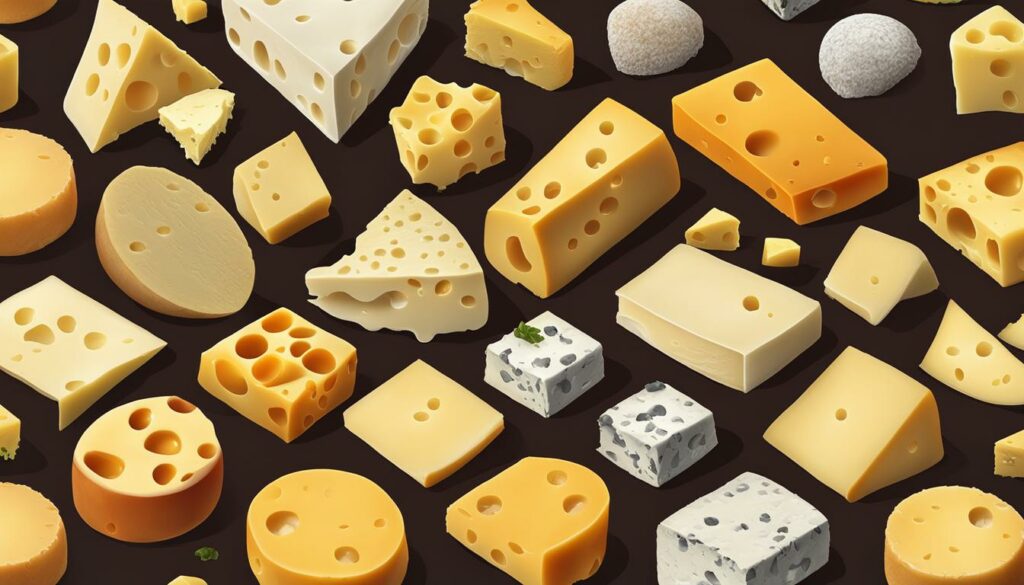
| Cheese Category | Examples |
|---|---|
| Fresh cheeses | Ricotta, Mozzarella |
| Semi-soft cheeses | Havarti, Colby |
| Semi-hard cheeses | Cheddar, Gouda |
| Hard cheeses | Parmesan, Pecorino |
| Blue cheeses | Roquefort, Stilton |
Cheese Classified by Milk Source
The milk used in cheesemaking plays a significant role in determining the flavor, texture, and characteristics of the cheese. Cheeses can be made from cow’s milk, goat’s milk, sheep’s milk, or buffalo milk, or sometimes a combination of these milks. Each type of milk imparts a distinct flavor profile to the cheese, leading to a wide range of taste experiences.
Comparing cow, goat, sheep, and buffalo cheese types allows for a greater understanding of the different milk sources and their contributions to the world of cheese.
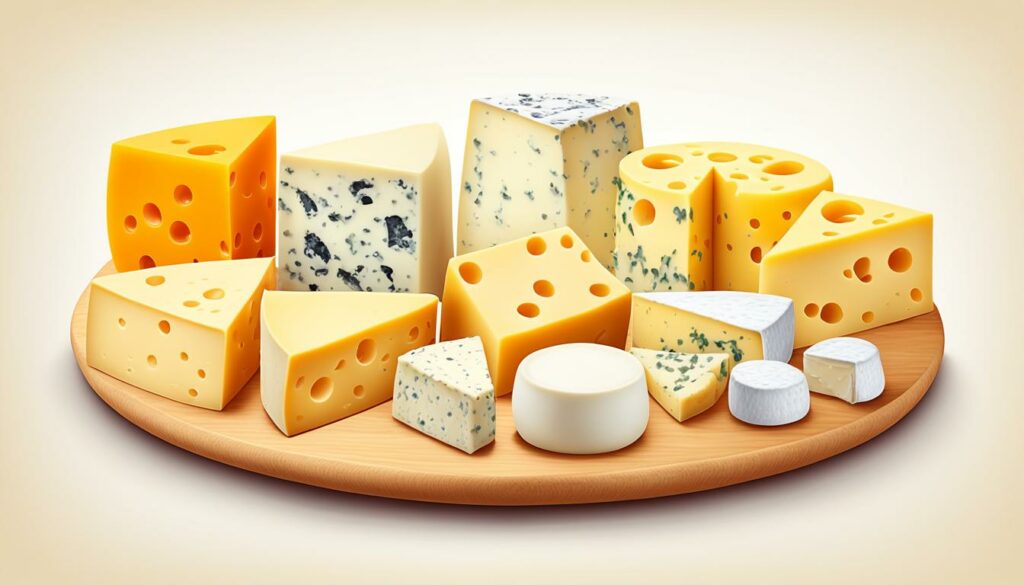
- Cow’s Milk: Cow cheese is the most common and widely consumed cheese variety. It tends to have a mild and creamy flavor, making it versatile for various culinary applications.
- Goat’s Milk: Goat cheese has a distinct tangy and slightly earthy flavor. It can range from creamy and spreadable to firm and crumbly, depending on the specific type.
- Sheep’s Milk: Sheep cheese is known for its rich and robust flavor. It often has a slightly nutty and sweet taste, with a smooth and creamy texture.
- Buffalo Milk: Buffalo cheese, commonly found in Mediterranean and South Asian cuisines, has a creamy and indulgent flavor. It is often used to make mozzarella and other soft cheeses.
Exploring the different milks used in cheesemaking opens up a world of taste sensations and allows cheese enthusiasts to discover their preferences among the diverse cheese varieties.
Regional Influence on Cheese Varieties
The rich tapestry of cheese varieties around the world is heavily influenced by the geographic regions where they are produced. Each region has its own unique set of factors, such as climate, soil composition, and local traditions, that contribute to the distinct flavors and textures found in their iconic cheeses. Understanding the regional influence on cheese varieties allows us to appreciate the connection between a cheese’s origin and its exceptional qualities.
Iconic Cheeses and Their Geographic Origins
Iconic cheeses have become synonymous with specific regions, reflecting the deep-rooted traditions and craftsmanship of local cheesemakers. From the crumbly Cheddar of Somerset in England to the creamy Camembert of Normandy in France, these cheeses not only showcase the expertise of their makers but also reflect the unique geography and climate of their birthplaces.
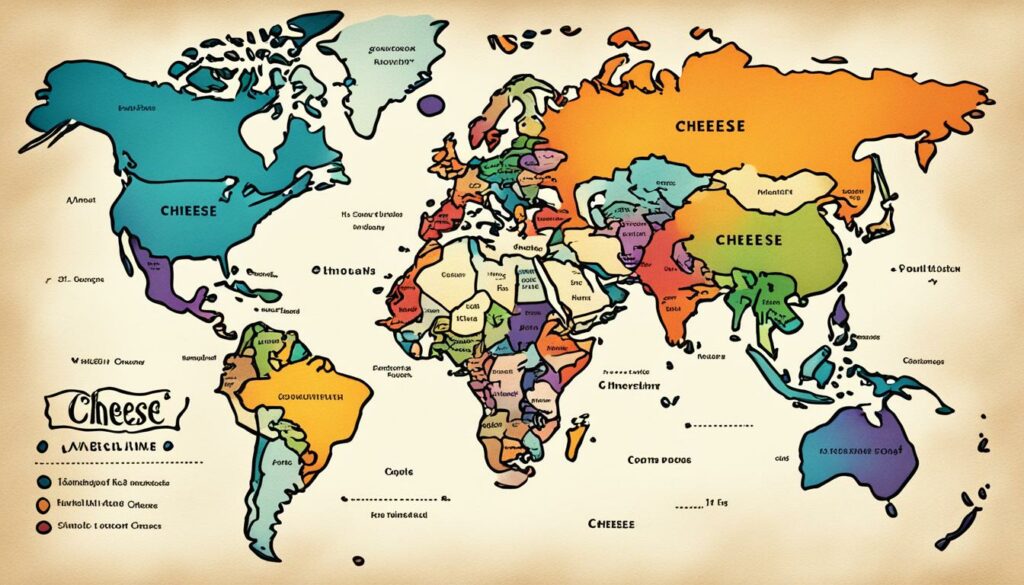
How Location Impacts Cheese Flavor and Texture
The location where cheese is produced can have a profound impact on its flavor and texture. The availability of diverse grazing lands, specific microclimates, and soil conditions can influence the diet of the animals and the composition of the milk used in cheesemaking. This, in turn, affects the taste and texture of the final product.
| Region | Iconic Cheese | Flavor | Texture |
|---|---|---|---|
| Roquefort, France | Roquefort | Sharp, tangy | Crumbly, creamy |
| Gouda, Netherlands | Gouda | Mild, nutty | Firm, smooth |
| Parmigiano Reggiano, Italy | Parmigiano Reggiano | Savory, umami | Granular, hard |
| Monterey, California, USA | Monterey Jack | Mild, buttery | Semi-soft, creamy |
The table above showcases a few examples of iconic cheeses and the specific flavor and texture characteristics associated with their respective regions. From the distinct tang of Roquefort to the smooth creaminess of Gouda, each cheese embodies the unique terroir of its origin.
The regional influence on cheese varieties is a testament to the importance of place and tradition in cheesemaking. Exploring these cheeses allows us to embark on a culinary journey around the world, savoring the rich flavors and textures shaped by the lands and cultures that have nurtured them for centuries.
Cheese Aging: Fresh to Vintage
The aging process is a crucial factor in the development of cheese. Cheeses can be classified into different age groups, each representing a distinct stage in their maturity. From fresh cheeses that are meant to be consumed immediately to aged cheeses that have undergone a lengthy maturation process, the spectrum of cheese aging offers a wide range of taste experiences.
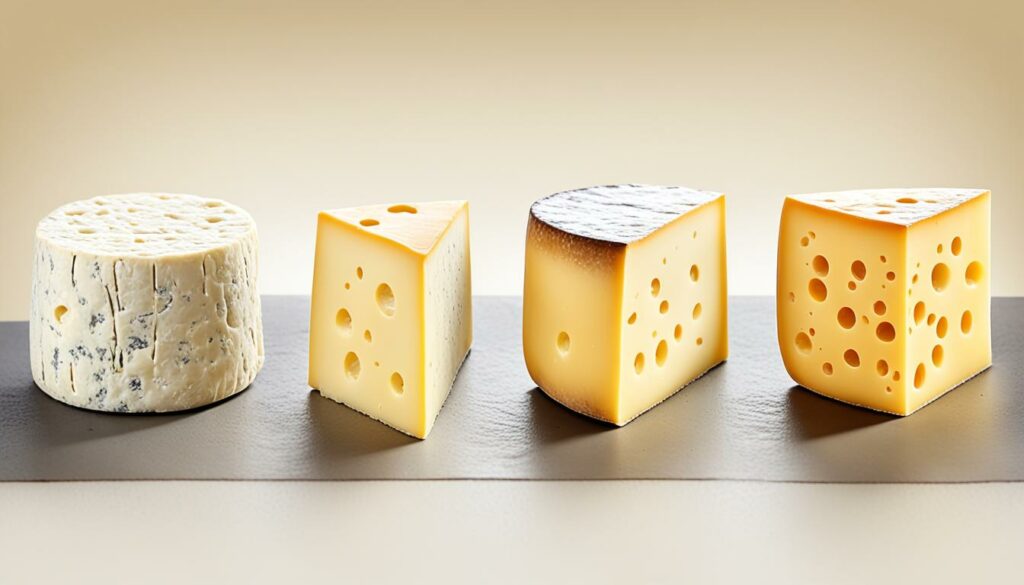
Aging transforms cheese in terms of flavor, texture, and complexity. As cheese ages, chemical reactions occur, resulting in the breakdown of proteins and the development of new flavors. Fresh cheeses are mild and creamy, with a soft and spreadable texture. On the other hand, aged cheeses tend to have a more intense flavor, with sharp and tangy notes, and their texture becomes firmer and crumbly.
The aging process affects the flavor, texture, and complexity of the cheese, leading to a wide range of taste experiences.
The length of the aging process varies depending on the type of cheese. Some cheeses require only a few days or weeks to develop their desired characteristics, while others may be aged for months or even years. Vintage cheeses, in particular, have undergone extensive aging, sometimes spanning several years, resulting in a pronounced and complex flavor profile that cheese connoisseurs appreciate.
Exploring the different stages of cheese aging allows cheese enthusiasts to discover the unique qualities that time imparts to each cheese variety. Whether enjoying the fresh creaminess of a young cheese or savoring the depth and richness of an aged or vintage cheese, the spectrum of cheese aging offers a diverse and exciting culinary journey.
The Textural Spectrum of Cheese Types
Cheese is known for its rich and diverse texture, which can range from soft and creamy to hard and crumbly. Understanding the textural spectrum of cheese types allows cheese enthusiasts to explore a wide variety of cheese textures and discover new favorites.
Soft to Hard: Textural Classifications Explained
The texture of cheese is influenced by several factors, including moisture content, aging process, and cheesemaking techniques. Soft cheeses, such as Brie and Camembert, have a smooth and creamy texture due to their high moisture content. On the other hand, hard cheeses like Cheddar and Parmesan have a firm and dense texture, resulting from a lower moisture content and a longer aging process.
There are also semisoft and semihard cheeses that fall in between, such as Gouda and Gruyère. These cheeses offer a balance of creaminess and firmness, providing a unique textural experience.
Exploring the textural classifications of cheese types allows cheese enthusiasts to appreciate the variety and versatility of different cheese textures. It opens up a world of possibilities in terms of pairing with other foods and creating diverse culinary experiences.
Age and Texture Correlation in Cheeses
In addition to the textural classifications, there is a correlation between age and texture in cheeses. As cheeses age, they tend to become drier and harder. The aging process allows flavors to develop and intensify while moisture evaporates, leading to a more concentrated and crumbly texture.
For example, young Cheddar cheese has a relatively mild and creamy texture, while aged Cheddar develops a sharper flavor and a crumbly texture. Similarly, young Gouda has a smooth and elastic texture, while aged Gouda becomes crumbly and crystalline.
Understanding the relationship between age and texture in cheeses offers a deeper appreciation for the craftsmanship and complexity behind the cheesemaking process. It allows cheese enthusiasts to explore a wide range of textures, from the creamy and soft to the crumbly and hard.

Flavor Profiles Across Cheese Varieties
Flavor is one of the most important aspects of cheese and plays a significant role in the overall cheese experience. Each cheese variety has a distinct flavor profile, ranging from mild and delicate to strong and pungent. Factors such as milk source, aging process, and the introduction of mold or bacteria cultures during cheesemaking contribute to the unique flavors found in different cheese varieties.
When exploring the flavor profiles across cheese varieties, you’ll discover a world of taste sensations. Let’s delve into some of the popular cheese flavors:
1. Mild and Delicate: These cheeses are typically creamy and have a subtle flavor. Examples include fresh Mozzarella, Brie, and Camembert.
2. Nutty and Buttery: These cheeses have a rich, nutty taste with a smooth and creamy texture. Examples include Gruyere, Fontina, and Swiss.
3. Tangy and Zesty: These cheeses pack a punch with their sharp and tangy flavors. Examples include Cheddar, Parmesan, and Blue Cheese.
4. Earthy and Mushroomy: These cheeses have a distinctive earthy, mushroom-like flavor. Examples include Gorgonzola, Truffle Cheese, and Cambozola.
5. Strong and Smoky: These cheeses offer robust, smoky flavors that can be an acquired taste. Examples include Smoked Gouda, Provolone, and Smoked Cheddar.
6. Spicy and Peppery: These cheeses have a spicy kick and can add heat to your dishes. Examples include Pepper Jack, Habanero Cheddar, and Jalapeno Jack.
Exploring the diverse range of cheese flavors allows for a deeper understanding and appreciation of the complexities of cheese. Whether you prefer the subtle nuances of a delicate cheese or the bold and intense flavors of a strong cheese, there’s a cheese variety to suit every palate.
Methods of Preparing Cheeses
Cheeses are prepared using various methods, each resulting in a different flavor, texture, and appearance. The craftsmanship behind cheesemaking involves careful attention to detail and an understanding of the techniques used to create unique cheese varieties.
There are several methods of preparing cheeses, including:
- Unripened Cheese: Some cheeses are made to be consumed fresh and do not undergo an aging process. These cheeses are typically soft and creamy with a mild flavor.
- Mold-Ripened Cheese: Certain cheeses, such as Camembert and Brie, undergo a mold-ripening process. This involves introducing specific fungi cultures that create the characteristic bloomy rind and develop complex flavors and aromas.
- Washed-Rind Cheese: Washed-rind cheeses, like Taleggio and Limburger, are bathed in brine or alcohol during the aging process. This washing promotes the growth of specific bacteria, resulting in a pungent aroma, distinctive orange or reddish rind, and a bold flavor.
- Pasta Filata Technique: The pasta filata technique, used in cheeses like mozzarella, involves heating and stretching the cheese curd to create a stringy, chewy texture. This process gives these cheeses their characteristic meltability and elasticity.
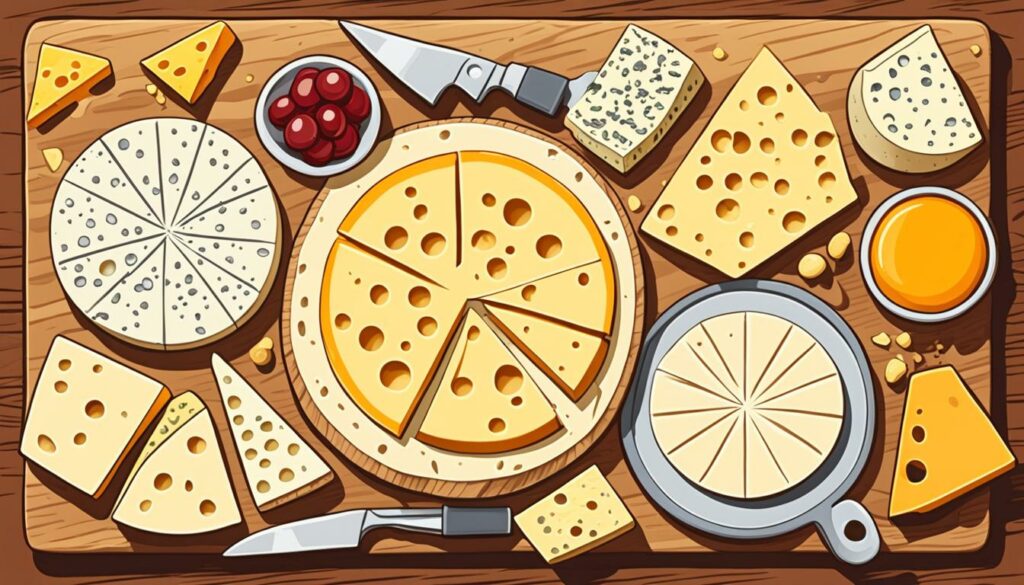
Understanding these different methods of preparing cheeses allows us to appreciate the skill and artistry that goes into creating the diverse range of cheese varieties we enjoy.
Cheese Categories and Popular Varieties
The world of cheese offers a vast array of options for cheese enthusiasts to explore and enjoy. To help classify and identify different cheese types, the US Dairy Association has established cheese groupings based on factors such as texture, flavor, and age. By exploring these categories and popular cheese varieties within them, cheese lovers can get a comprehensive overview of the diverse cheese landscape.
US Dairy Association’s Cheese Groupings
The US Dairy Association has categorized cheeses into various groups to provide a framework for understanding and appreciating the different types of cheese available. These groupings are based on a combination of factors such as milk source, aging process, and flavor profile. Some of the main cheese categories recognized by the US Dairy Association include:
- Fresh Cheese
- Semi-soft Cheese
- Hard Cheese
- Blue Cheese
- Washed-rind Cheese
- Flavored Cheese
- Processed Cheese
Each category encompasses a wide range of cheese varieties, each with its own distinct characteristics and flavors. Exploring these groupings allows cheese enthusiasts to delve deeper into the world of cheese and discover new favorites.
Exploring Soft-Fresh to Hard Cheeses
Within the cheese categories established by the US Dairy Association, there are numerous popular cheese varieties to explore. From soft-fresh cheeses that are young and creamy to hard cheeses that have been aged for extended periods, there is a wide spectrum of textures and flavors to discover.
In the realm of soft-fresh cheeses, popular varieties include creamy Brie, tangy Chèvre, and mild Mozzarella. These cheeses are often enjoyed on their own or used as a versatile ingredient in a variety of dishes.
Moving towards the firmer end of the spectrum, popular semi-soft and semi-hard cheeses include Cheddar, Gouda, and Swiss. These cheeses offer a balance of flavor and texture, making them widely loved for snacking, melting, or adding to recipes.
For those who prefer a more intense and robust cheese experience, the world of hard cheeses awaits. Parmesan, Gruyère, and Pecorino Romano are just a few examples of the popular hard cheeses known for their bold flavors and crumbly textures.
Exploring the wide range of cheese textures and flavors from soft-fresh to hard cheeses allows cheese enthusiasts to expand their palates and embark on a delightful cheese journey.
Cheese Consumption and Culinary Uses
The Versatility of Cheese in Recipes
Cheese is a versatile ingredient that can be used in a variety of culinary creations. Its rich and diverse flavors, along with its unique texture, make it an essential component in countless dishes. From classic cheese-based recipes like mac and cheese to more innovative dishes, cheese adds depth of flavor, richness, and indulgence to a wide range of foods.
Whether it’s a gooey mozzarella in a warm Caprese salad, a creamy Brie spread on a crusty baguette, or a sharp cheddar melted on a juicy burger, cheese elevates the taste experience and adds a delightful indulgence to any meal. Its versatility allows for creativity in the kitchen, as it can be melted, grated, crumbled, or used as a topping or filling in both sweet and savory dishes.
When it comes to culinary uses, the possibilities are endless. Cheese can be incorporated into breakfast dishes like omelettes or used as a flavorful component in salads, sandwiches, and pasta dishes. It can also be the star ingredient in appetizers and party platters, such as cheese boards, where different types of cheeses are paired with fruits, nuts, and other accompaniments.
For those with a sweet tooth, cheese can be used to create delectable desserts like cheesecakes, fruit tarts, and cheese-filled pastries. Its tangy, creamy, and savory notes can balance the sweetness of other ingredients, resulting in a harmonious combination of flavors.
Exploring the culinary uses of cheese provides inspiration for incorporating this beloved ingredient into everyday cooking. Whether you’re a seasoned chef or a home cook looking to experiment, cheese is sure to enhance your dishes and delight your taste buds.
Tasting Notes for Pairing Cheese with Foods
Tasting and pairing different cheeses with complementary foods is a delicious adventure that allows you to discover a myriad of flavors and textures. The art of cheese pairing involves selecting foods and beverages that enhance the taste and experience of cheese, creating a harmonious balance on the palate.
When considering cheese pairings, it’s important to take into account the flavor profile, texture, and intensity of both the cheese and the accompanying food or drink. The goal is to find combinations that complement and enhance each other, resulting in a delightful culinary experience.
Here are some tasting notes to guide you in pairing cheese with foods:
- Soft and Fresh Cheeses: These creamy and mild cheeses, such as fresh goat cheese or ricotta, pair well with fruits like berries or figs. The subtle tanginess of the cheese complements the natural sweetness of the fruits.
- Semi-Soft Cheeses: Cheeses like Gouda or Havarti have a buttery and slightly mellow flavor. They pair beautifully with crusty bread, cured meats, and pickles, creating a balanced combination of flavors and textures.
- Hard Cheeses: Aged cheddar or Parmesan, with their robust and sharp flavors, are best paired with foods that can stand up to their intensity. Nuts, dark chocolate, and dried fruits provide a rich and contrasting taste experience.
- Blue Cheeses: The bold and pungent flavors of blue cheeses like Roquefort or Stilton are balanced by sweeter elements. Pair them with honey, pears, or walnuts to create a harmony of flavors.
- Firm and Aged Cheeses: Cheeses with a firm texture and complex flavors, such as Gruyère or Manchego, can be paired with charcuterie, olives, or honey for a combination that showcases their depth and richness.
By exploring the different tasting notes and experimenting with various pairings, you can create delightful combinations that highlight the unique characteristics of each cheese and elevate your culinary journey.
When it comes to cheese consumption, its culinary uses and pairing possibilities are an endless source of inspiration. From delightful recipes to flavor exploration, cheese offers a world of possibilities for food enthusiasts. So, embrace the versatility of cheese in your kitchen and elevate your dining experiences with its rich flavors and indulgent textures.
Conclusion
The world of cheese is a vibrant and ever-growing family, with an endless assortment of tantalizing flavors and textures awaiting exploration. From the milky freshness of soft cheeses to the bold intensity of aged varieties, there is a cheese to suit every taste and occasion.
By delving into the diverse range of cheese types, cheese enthusiasts can develop a deeper appreciation for the craftsmanship and artistry that goes into the production of these delectable creations. Each cheese tells a story, with its unique regional influences, meticulous aging processes, and distinct flavor profiles.
So go ahead and invite a world of cheese into your home. Explore the local cheesemongers, gourmet markets, and online purveyors to discover new and exciting cheese varieties. Whether enjoyed on a cheese plate with a glass of wine, melted into a comforting dish, or elevated in gourmet recipes, cheese is sure to add a touch of indulgence and flavor to your culinary adventures.

